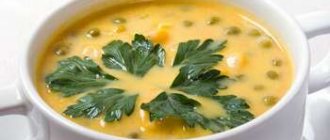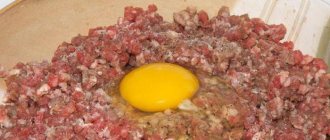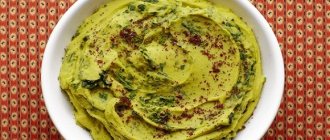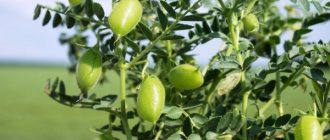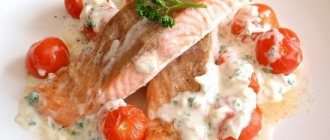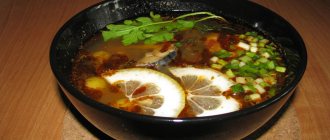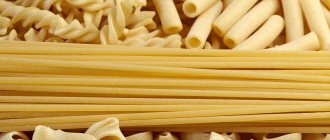Peas are one of the most ancient crops, the pods and seeds of which were found in the tombs of Egyptian pharaohs. The ancestor of the cultivated variety, field peas, grows in the meadows of the entire European part of Eurasia. Peas were first cultivated as a food crop in Ancient India. In Europe, the Dutch were the first to appreciate it - the side dish of peas was included in many national dishes. The plant is unpretentious, annual, one of the representatives of the Legume family. Currently grown on all continents except Antarctica.
Compound
Peas are a very valuable source of vegetable protein, carbohydrates and vitamins.
However, its main nutritional value lies in the high concentration of trace elements and mineral salts.
Minerals include macroelements such as phosphorus (329 mg), potassium (873 mg), calcium (115 mg), chlorine (137 mg), and magnesium (107 mg). It is also rich in copper, manganese, aluminum, molybdenum, cobalt, boron, silicon, chromium, fluorine, selenium, titanium, nickel, strontium and tin.
Thus, a small pea contains almost the entire periodic table.
Fruits contain a huge amount of dietary fiber, fatty acids, fats, natural sugars, as well as vegetable protein and starch.
Peas are a product containing amino acids that are extremely important for the human body. These include tryptophan, cysteine, methionine and lysine.
This culture contains the following vitamins: PP, A, H, K, E and B, as well as beta-carotene.
Features of eating peas for various diseases
Not all people are absolutely healthy. Most people know their diagnosis: this rule applies to both children and adults. For some diseases, peas should be eaten with caution:
| illness | possibility of use | how to neutralize harmful effects |
| flatulence, duodenitis, syndrome | with the permission of the gastroenterologist | eating in the form of porridge |
| gout | not recommended | not recommended |
| excess weight | contraindicated in diets | not recommended |
| pancreatitis | contraindicated | contraindicated |
| nephritis | with the therapist's permission | consumption in small doses |
Calorie content
Since peas contain a large amount of carbohydrates and proteins, they are superior in calorie content to certain types of meat (lean beef). Its nutritional value is close to that of beans, which have been called "poor man's meat", and their chemical composition is almost identical.
Watching your calories? Read on - calorie content of kiwi.
This news is about the benefits and harms of carrots.
Find out the secrets of grandmothers about the beneficial properties of cabbage! https://stroy-telo.com/dieta/produkty/polza-i-vred-kalorijnost-i-pitatelnost-pogovorim-o-kapuste.html
When analyzing the calorie content of the product, it was found that the energy value of peas is 298 kilocalories, of which 82 kcal are proteins, 18 kcal are fats, 198 kcal are carbohydrates.
Brain varieties of this fruit have taste advantages over table varieties. They contain high concentrations of sugar and low starch content. However, as they ripen, the concentration of sugars decreases and they turn into starch.
Canned peas have lower calorie content compared to fresh ones, but they do not bring much benefit.
Planting and caring for a plant
Peas are usually planted in areas where cabbage, cucumbers, pumpkins or potatoes previously grew. You should not fertilize the soil just before planting. It is better to apply fertilizer before growing previous crops. In this case, the fruits will be more tender.
Since the crop is characterized by good resistance to cold, it is advisable to sow it in early spring. But not earlier than the second half of April. You need to wait until the soil dries out after winter. In summer, peas can be planted until the tenth of July. However, in this case it is recommended to use early ripening varieties.
Scheme of planting in the ground
Before planting peas, you need to make sure that the soil in which they will be planted is fertile, without excess readily available nitrogen. In addition, the crop needs good lighting. You should select sunny areas that are as protected from the wind as possible.
Before planting, the seeds can be soaked in water (at a temperature of about forty degrees). The furrows for planting should be up to twenty-five centimeters wide. How wide the space between the rows should be depends on the height of the plant (a description of the specific variety can be found on the package with the seeds).
Compost is first applied to the furrow, after which the seeds are sown (at a distance of about five centimeters from each other). Planting depth is up to five centimeters. After placing the seeds, the furrows are backfilled.

Supports
Caring for the plant is easy. It is enough to carry out regular watering, weeding and timely construction of supports. The culture is resistant to cold, but does not tolerate significant increases in temperature. Therefore, in the hot season, it is recommended to water abundantly (the amount of water is up to ten liters per square meter).
Peas are a tall herbaceous plant. For its normal development, it is necessary to take care of the supports. Near the planted plants, pegs should be driven into the ground, at a distance of about a meter from each other. Next, stretch the mesh between them. This design will be an excellent support for plant shoots.
The plant bears fruit for a long time, in some cases up to forty days. This feature allows you to harvest over a long period of time.
If you need to collect mature beans, you should wait until the lower pods on the bush are completely ripe, and only then harvest. The collected seeds can be used as material to replant peas in the future. However, it must be taken into account that their germination lasts only two years.
Peas: beneficial properties
Many people know about the benefits of sprouted grains, but not everyone understands what they are.
The bottom line is that during the germination process, enzymes are activated, causing the rapid breakdown of carbohydrates, fats, proteins, with the formation of easily digestible compounds. Also in sprouted grains the concentration of vitamins increases several times.
The same processes occur in sprouted peas, which has a beneficial healing effect on the human body.
Mineral salts, which are found in large quantities in pea grains, contribute to the process of removing excess fluid from the human body.
Recipes for dishes with peas

You can familiarize yourself with the following methods of preparing peas in the recipes offered in the article:
- Pea porridge with stew
. You should prepare in advance 2/3 cup of peas, preferably crushed, an onion, carrots and a can of stew - 250-300 g. The rest of the seasonings and sunflower oil for frying are probably in every housewife's kitchen. The peas are soaked for 6-8 hours, then the water is drained, another is poured in and the beans are boiled until tender with a bay leaf. While the peas are boiling, the vegetables are chopped and sautéed with sunflower oil. Add the stew to the pan with the vegetables, bring to a boil - the liquid should evaporate. At this time, boiled peas are pounded, mixed with vegetables and stew, and added salt if necessary. It should be eaten hot, each serving can be sprinkled with herbs. - Hummus
. This dish resembles the consistency of pea porridge, only with a delicate, delicate taste. Ingredients for hummus: a glass of peas, one lemon, half a glass of sesame seeds, garlic, olive oil. To traditional salt you need to add chili pepper and coriander. The peas are also soaked, boiled until fully cooked, and at this time the paste - tahini - is prepared. In a dry frying pan, brown the sesame seeds, chop them, add lemon juice and ice water, stirring until you get a homogeneous puree-like paste. The finished peas are blended into porridge with a blender, mixed with tahini, and seasonings are added to taste. Before serving, it is advisable to sprinkle with pomegranate seeds or black sesame seeds. - Pea soup with smoked ribs
. The set of ingredients for this dish is the simplest: a glass of dry peas, 300 g of smoked ribs, 1 carrot and onion each, 2-3 potatoes, 2-3 cloves of garlic, seasonings to taste, vegetable oil for frying. The peas are soaked as usual, and the broth is boiled in a 2 liter saucepan based on the smoked ribs. If you like boiled peas, place them together with the meat in boiling water. All vegetables are peeled, carrots and onions are sautéed separately in sunflower oil. After 40-50 minutes of cooking, potatoes, cut into even slices, are placed in a pan with broth, and after another 10 minutes, sautéed vegetables are added. The soup will be ready when the potatoes are completely cooked. 2-3 minutes before turning off, add spices to taste - salt, a mixture of peppers, bay leaf and chopped garlic. Before serving, it is advisable to sprinkle each plate with chopped parsley and dill. - Pea soup for vegans
. Ingredients: split peas, carrots - 2 pieces, onions - 2 pieces, water, vegetable oil and necessary spices. The quantity of products is calculated for 1.5 liters of water. The peas are soaked for 6-8 hours, the water is drained, and the beans are set to cook. The vegetables are sautéed together, then added to almost finished peas and cooked. Spices - to taste. You can also add potatoes, bell peppers, frozen cauliflower or broccoli to the soup. - Dosas
. This very interesting Indian dish is easy to prepare, but the preparatory stage is long. The peas should be soaked for 8 hours, and then the dough should be left to infuse for a day. Ingredients for cooking: basmati rice and dry peas - 100 g each, turmeric, safflower oil, water, salt and pepper. Soak peas for 8 hours, basmati rice for 1 hour. Part of the liquid is drained, leaving a little, mix peas and rice, grind with a blender until mushy. The mixture is left to absorb each other’s juices for 24 hours, then seasonings are added to the mixture and fried, like regular pancakes or pancakes, in safflower oil. The dough is poured into the pan and, after one side is browned, turned over to the other. Sunflower oil will give an Indian dish an almost Slavic taste. - Pea casserole
. This is a dish of traditional Russian cuisine. You should prepare in advance: dried porcini mushrooms - 30 g, a glass of peas - they should be pre-soaked, carrots, melted butter - 60 g, cream 30-32% - 20 g, onions - 2 pieces, eggs - 2 pieces, breadcrumbs. Seasonings: red and black pepper, sea and regular salt. The prepared peas are boiled until tender, the mushrooms are soaked for 20 minutes, the whole onion is boiled for the same amount of time, and cut into large pieces. Peel the carrots and onions, cut the carrots into strips, and cut the onion into half rings (it should be placed in the freezer for 5 minutes). Boiled peas are pounded into puree, adding cream and melted butter - 1/3 of the total amount. Vegetables are sautéed separately. All processed ingredients are combined, eggs and seasonings are added and mixed until completely homogeneous. Preheat the oven to 180 degrees, place parchment in the pan and grease it with oil. Pour in the pea batter, distributing evenly. Bake for 40 minutes. Grease the finished casserole with the remaining melted butter. It will be tastier if each piece is dipped in sour cream before eating. - Pea sausage
. Amount of products needed: dry peas - a glass, water - 2.5 cups, beet juice - 2 tablespoons, garlic - 2 cloves, sunflower oil - 1/3 cup, agar-agar plate, salt - a teaspoon. Seasonings to taste - a mixture of peppers and crushed nutmeg. Dry peas are fried in a dry frying pan until golden brown and ground into flour. To make the mass more homogeneous in the future, it is sifted. Place a pan of water on the fire, as soon as the water boils, pour pea flour into it and cook, stirring constantly so as not to burn. Agar-agar is diluted in cold water and added to the pea mixture 2-3 minutes before turning off. When the pea flour is completely cooked and the mixture thickens, add all the seasonings and add beet juice. Stir until completely homogeneous and pour into the mold. It is very convenient to use a cut small plastic bottle, greased from the inside with oil. The form hardens in the refrigerator in 2-2.5 hours. You can add fried bacon or pieces of lard to the sausage mince for flavor.
Dry peas are never served al dente, that is, slightly raw.
It needs to be cooked until cooked, to the point where it begins to soften. Pea dishes should be introduced into the diet no more than 2 times a week; the serving size should not exceed 150 g for women and 200 g for men of average build, taking into account diseases of the digestive system.
Benefits and harms
From a medical point of view, peas are a very useful product, but they have certain disadvantages. The fact is that due to the high concentration of coarse fibers and sugars, its use leads to increased flautence (the emission of gases from the anus, which is often accompanied by a characteristic unpleasant sharp sound).
Peas are a very powerful antioxidant, which is why they are used to prevent the development of cancer.
The amino acids that make up this culture are similar to animal proteins, so it can be a wonderful alternative to meat.
Peas are very useful as a means to prevent obesity and anemia. It helps improve the functioning of the heart, blood vessels, liver, and kidneys. Thanks to peas, it is possible to control digestive processes.
Young green peas are also an excellent anthelmintic, as well as a product that can relieve swelling.
Pea puree is recommended for patients who suffer from gastric ulcers, as it perfectly reduces acidity. Peas are also included in the diet to prevent dermatitis and seizures. Its grains contain fiber, which helps cleanse the intestines of toxins. Nicotinic acid maintains normal blood cholesterol concentrations and also reduces the likelihood of developing cancer.
Thiamine serves to improve brain function and supply energy to the body. Eating peas is also very beneficial for children and teenagers. It stimulates growth processes, maintains normal muscle tone and healthy appetite, and has a beneficial effect on mental abilities.
In adults, thiamine slows down the aging process and protects the body's cells from the harmful effects of bad habits (alcohol and smoking). Pea infusion is used to relieve toothache and gum disease.
Pea flour also has miraculous properties. If you eat at least one teaspoon a day, digestion will soon be restored, and even the most persistent, painful constipation will subside. Pea flour also helps with headaches. In this case, you need to take two teaspoons of it after meals.
In cosmetology, peas are used as masks to improve complexion, and also as an effective remedy for getting rid of swelling and acne. Pea flour is also used for cosmetic masks, and in ancient times it was used as powder.
Peas are an excellent cleanser - they are used as a way to get rid of excess weight. To do this, dry fruits are soaked for ten to twelve hours, after which they are passed through a meat grinder with a fine mesh.
This product should be eaten in pure form throughout the day, or added to various soups or salads. After a week, a break should be taken, after which the course is repeated.
Fresh or cooked peas are contraindicated for acute nephritis and gout. Also, it should not be used as food in case of exacerbation of diseases of the gastrointestinal tract, cholecystitis and thrombophlebitis. It is important to remember that older people should not often add this product to their diet.
What does the plant look like and what groups of varieties are distinguished?
Peas were cultivated in Ancient China and India. In these countries it was considered a symbol of wealth. Ancient Greece and Rome also knew about culture. But here it was used by the poor. Surprisingly, over time, representatives of royal blood began to consume the culture. Pea-based dishes were very popular among the kings of France in the sixteenth century.
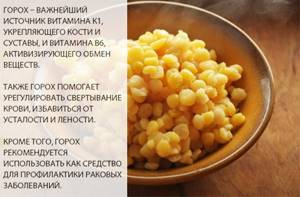
Product benefits
Peas are an annual herbaceous plant. The culture has a full stem with clinging tendrils placed on it. The color of the stem depends on the specific variety and varies from dark bluish-green to light green. Most varieties have white flowers. They are self-pollinating.
The plant belongs to legumes. Characteristics such as color, shape and size of beans depend on the specific variety. The number of seeds in one bean ranges from four to ten. They are located in one row. They also differ depending on the specific variety and color of the seeds. But there is one peculiarity - their peel is always painted in the color of the plant’s flowers.
Today, there are three main groups of crop varieties, which, in turn, are divided into subspecies. The most applicable varieties are:
- Cerebral. The name comes from the appearance of overripe seeds - they are wrinkled. A sweet variety, which is why it is sometimes confused with sugar snap peas. Most often used for preservation. Since the seeds do not soften during cooking, they are rarely used in cooking.
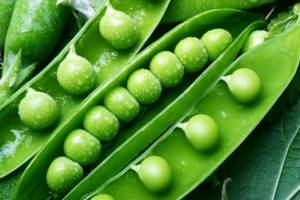
Peeling. The surface is smooth. Used for soups. When overripe, the seeds acquire a floury taste, so young seeds are more often used.
- Sugar. Unripe beans are used. A special feature of the group is the absence of a parchment partition in the beans. The fruits have a sweet, meaty taste. If dried, they become wrinkled (this feature is explained by the high moisture content in immature seeds).
Pleasant taste and rich composition (vitamins, microelements, proteins, carbohydrates) are not all the benefits of peas. The height and timing of the plant's ripening also make it attractive to gardeners. With the correct selection of planting varieties, pea fruits can be harvested within two to three months (if planted in early spring).
Another feature of the plant attracts the attention of gardeners - it is an excellent green manure. Microorganisms develop in the roots of the crop, assimilate nitrogen and accumulate it in the soil.
Vitamins
Fat-soluble vitamins in peas include A, beta-carotene, E and K. Water-soluble vitamins include vitamins C, B1, B2, B3 (PP), B4, B5, B6 and B9.
>»> >»> >»> >»> >»> >»> >»> >»> >»> >»> >»> >»> >»> >»> >»> >»> >»>
| Vitamins, content | Share of daily value per 100 g | |
| Vitamin A | 7.0 mcg | 0,8% |
| Beta carotene | 89.0 mcg | 1,8% |
| Alpha carotene | 0.0 µg | 0,0% |
| Vitamin D | 0.0 µg | 0,0% |
| Vitamin D2 | n/a | 0,0% |
| Vitamin D3 | n/a | 0,0% |
| Vitamin E | 0.1 mg | 0,6% |
| Vitamin K | 14.5 mcg | 12,1% |
| Vitamin C | 1.8 mg | 2,0% |
| Vitamin B1 | 0.7 mg | 60,5% |
| Vitamin B2 | 0.2 mg | 16,5% |
| Vitamin B3 | 2.9 mg | 18,1% |
| Vitamin B4 | 95.5 mg | 19,1% |
| Vitamin B5 | 1.8 mg | 35,2% |
| Vitamin B6 | 0.2 mg | 13,4% |
| Vitamin B9 | 274.0 mcg | 68,5% |
| Vitamin B12 | 0.0 µg | 0,0% |
